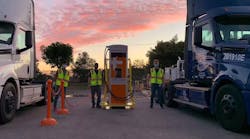Environmental Defense Fund (EDF) just launched the Fleet Electrification Solutions Center, a free online resource for truck electrification, to connect fleet leaders with alternative-power solutions.
“We are at a critical juncture in the climate crisis, and fleet electrification is a feasible solution that can begin to address this historic challenge while also reducing harmful pollution from diesel trucks in communities across America,” said Lindsay Shigetomi, a zero-emission truck deployment analyst at Environmental Defense Fund. “EDF is launching the Fleet Electrification Solution Center because we want to make sure fleet decision-makers have all the tools they need to electrify their fleets—right at their fingertips. With the solutions center, we are making the electrification journey more manageable and easy to navigate.”
More than 30 million trucks on U.S. roads generate 7% of U.S. greenhouse gas emissions—more than aviation, maritime shipping, and rail combined. Yet zero-emission trucks only account for a small fraction of the heavy-duty vehicles on U.S. roads. EDF worked with leading experts, industry professionals, and fleet leaders to identify barriers to fleet electrification and create a tool to overcome these barriers.
See also: Pitt Ohio terminal previews the future of fleet facilities
Designed to meet fleets wherever they are in their electrification journey, the FESC is organized into five phases, with each phase capturing best practices from fleets at the forefront of truck electrification and distilling them into a straightforward but thorough online resource. Users can create an account to make a customized plan and track their progress or simply search the extensive resource library for reports or case studies to accelerate their electrification journey.
“Running electric trucks takes diligent planning and skilled problem-solving,” said Taki Darakos, VP of vehicle maintenance and fleet services at Pitt Ohio. “The solutions center can help fleets navigate the complexities of fleet electrification. There is no other resource that distills as much information in such an accessible and comprehensive format.”
Medium- and heavy-duty diesel trucks are the largest contributors to ozone-forming nitrogen oxides (NOx) in the transportation sector while making up 4% of vehicles on U.S. roads. Smog-forming NOx and other fine particulate pollution from trucks have been linked to adverse health impacts in everyone from infants to the elderly, particularly in overburdened communities that live near major transit hubs and corridors.
“Zero-emission vehicles are here and, in many cases, are capable of doing the job of their diesel counterparts while cutting down on harmful emissions, reducing operational expenses for fleets, and advancing environmental justice,” said Jessie Lund, lead project manager at CALSTART. “While other resources exist, many are inaccessible and none are as comprehensive as the solutions center. This tool will help fleets, large and small, navigate everything from planning to implementation by providing a clear, easy-to-follow map on the road to electrification.”
The launch of the FESC comes at a pivotal moment in the electric truck transformation.
In August, President Biden signed the Inflation Reduction Act, which provides a multibillion-dollar investment in zero-emission trucks. Once these tax incentives are implemented, the purchase price for a wide range of zero-emission trucks could reach parity with diesel alternatives by as early as 2023, according to a recent EDF analysis. While policy supports make trucks more affordable, an ever-expanding number of vehicle models are available today and hundreds of fleets are already deploying EVs.
“There has never been a better time for fleets to take the next step on their electrification journey,” said Mike Roeth, executive director for the North American Council for Freight Efficiency. “There are high-quality, affordable zero-emission vans, trucks, and heavy-duty tractors on the market today, and costs and efficiency are only going to keep improving. The solutions center will make it easier for fleets to navigate barriers to entry by bringing together the best tools and information in the industry in one place.”



